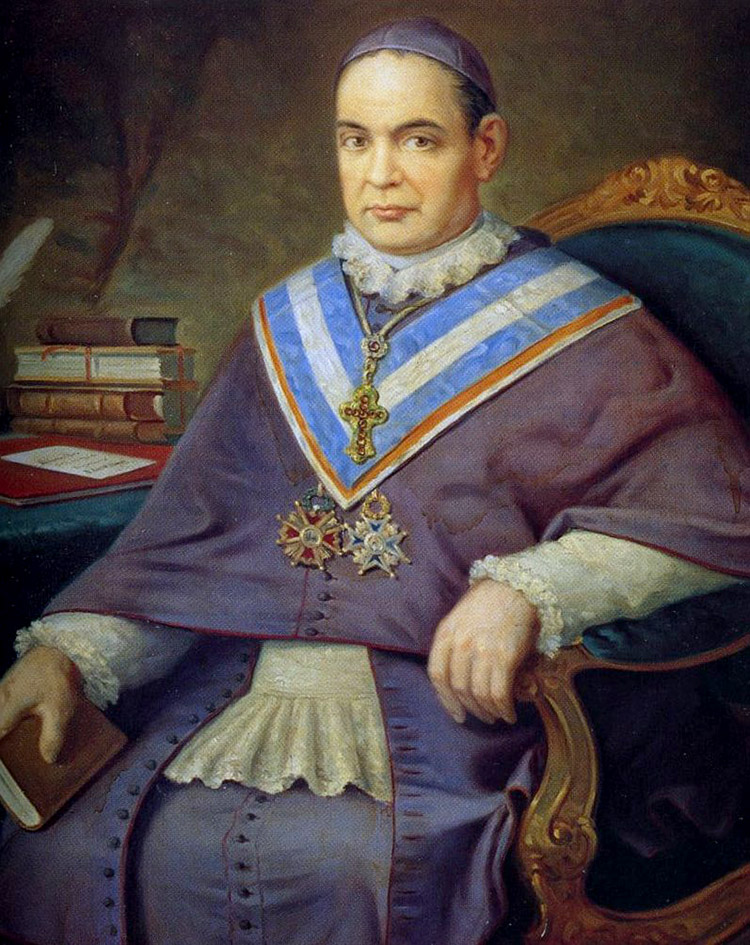Saint Anthony Mary Claret
Saint Anthony Mary Claret
Born: December 23, 1807 in Sallent, Barcelona, Spain
Died: October 24, 1870 (aged 62) in Fontfroide, France
Beatified: February 25, 1934 by Pope Pius XI
Canonized: May 7, 1950 by Pope Pius XII
Feast day: October 24
Attributes: Bishop’s robe, crozier, an open book, catechism, 2 students beside him at his side and having his bent arm pointing to the sky
Patronage: Textile merchants, weavers, savings (he taught the poor the importance of savings), Catholic press, Claretians, Dioceses of the Canary Islands, Claretian students, Claretian educators and Claretian educational institutions, Foundations
Saint Anthony Mary Claret was born on December 23, 1807 in Barcelona, Spain.
In 1829, he entered the Diocesan seminary at Vic. He took his vows as a priest on June 13, 1835. He received a position in his home parish and continued to study theology until 1839.
Anthony yearned to become a missionary, so he went to Rome and became a Jesuit novitiate. However, due to poor health, he left that position and returned to a pastoral ministry in Spain, where he also worked to help the poor in the region.
He was then sent as a missionary to Catalonia. He spoke the Catalan language and his sermons attracted large crowds.
After an attempt on his life by an anti-clerical in 1848, Anthony was sent to the Canary Islands for 15 months. There, he gave retreats where his sermons were so popular he would need to preach outside the church because the size of the crowd exceeded the church’s capacity.
He returned to Spain the following year and founded the Claretians – the Congregation of the Missionary Sons of the Immaculate Heart of Mary. The order was approved by Pope Pius IX in December of 1865.
That year Claret also established the Librería Religiosa, a famed religious library in Barcelona now known as the Librería Claret.
Queen Isabella II of Spain asked Pope Pius IX to make Claret the archbishop of Cuba, and he sailed for the island in 1850. There, he reorganized and strengthened the seminary while founding a hospital and schools, including trade schools for disadvantaged children, and credit unions to provide financial services to the poor.
Anthony Maria Claret also wrote books on religious themes and practical agricultural methods. In August of 1855, along with Maria Antonia Paris, he established the first women’s order in Cuba, the Religious of Mary Immaculate.
He made visits to Cuban hospitals and jails, denounced racist views and was a defender of the less fortunate. Those actions created opposition to his presence among some, and he was once again attacked by an assassin, who cut Claret’s cheek.
Anthony returned to Spain in early 1857 to become confessor to Queen Isabella II and archbishop of Trajanopolis. He focused his energy on creating educational opportunities and helping the poor as he lived a frugal life in a hospice.
He became rector of a monastic school, where he established a science laboratory, museum, library and schools of music and language.
Queen Isabella II was dethroned by a revolution in 1868, and Claret accompanied her to an exile in France. There, he preached for a time before traveling to Rome to see Pope Pius IX.
Claret continued to travel with the exiled Spanish court, while preaching and providing literature to the citizens of wherever they were.
He traveled to Rome in 1869 for the first Vatican Council. However, due to health problems he went to the French Pyrenees before retiring at the Cistercian abbey at Fontfroide, Narbonne in the south of France.
He died there on October 24, 1870 at the age of 62. His remains were buried at Vic and in 1897 were transferred to the mission house there. During the disinterment it was reported that his heart was incorrupt.
During his life, Claret wrote more than 144 books and was credited with a resurgence of the Catalan language.
Pope Leo XIII declared Anthony Maria Claret venerable in 1899. He was beatified by Pope Pius XI in 1934 and canonized a saint by Pope Pius XII on May 7, 1950.


